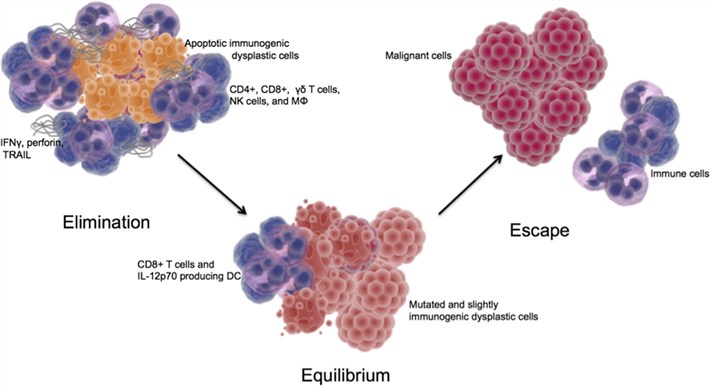Mechanisms of Immunosurveillance
Immunosurveillance
The immune system plays a significant role as an inhibitory or stimulating factor in immunosurveillance against tumors. The immunosurveillance refers that the immune system of the host recognizes antigens of newly arising tumors through the expressed tumor-specific antigens and eliminates all these tumor cells. It is similar to homograft rejection, maintaining tissue homeostasis in complex multicellular organisms. Tumor cells must develop different strategies to escape immune surveillance and attack from the immune system, such as secretion of factors that regulate the immune cells. The cytolytic T cells and natural killer cells physically eliminate cancer cells, which is essential in preventing and/or eliminating tumors during immunosurveillance.
 Fig.1 Tumor immunosurveillance and immunoediting. (Raja, 2018)
Fig.1 Tumor immunosurveillance and immunoediting. (Raja, 2018)
Mechanisms of Immunosurveillance
The premise of using immunotherapy to treat malignancies is predicated on the cooperative function of innate immune cells, in which specific lymphocytes are served to surveil damaged and dysplastic cells further to induce apoptosis or direct cytotoxic killing. Two critical components of the surveillance are activated cytotoxic CD8+ T-cells and NK cells. In the early elimination phase, there is immune detection of malignant cells and clearance; however, some malignant cells may succeed in altered transcription for immune evasion or enter the escape phase. During the elimination phase, there is continuous T-cell mediated eradication of malignant cells via effector responses such as CD8+ T-cells and NK cells, as well as macromolecules such as TNF-related apoptosis-inducing ligands.
Viral stimulation of the adaptive immune system seems to stimulate anti-tumor immune surveillance systems, increasing the effectiveness of oncolytic virus therapy. Oncolytic viruses not only mediate direct tumor oncolysis but also induce or reactivate tumor immune surveillance programs, in combination with their inherent properties. The mechanisms by these oncolytic virus therapies include direct immune cell stimulation, direct receptor-ligand signaling disruption, and suppression of tolerogenic pathways present in the tumor. It might not be crucial for the oncolytic virus to eradicate a tumor to be therapeutically effective ultimately. Instead, tumor cells subjected to the oncolytic activities of oncolytic viruses release large amounts of tumor proteins and factors, making tumor cells vulnerable to immune surveillance. In general, viruses quickly establish a tumor-specific infection leading to localized inflammation, further express cytokines, or directly affect the immune system. Meanwhile, the expression of tumor-specific antigens can be facilitated by antigen-presenting cells. These ways elicit both memory and effector cells maintained to induce lasting memory responses to kill residual and uninfected tumor cells, ultimately.
Creative Biolabs possesses enriched experience in oncolytic virus therapy development, and our scientists are devoted to meeting every client's requirements with our novel strategies and proprietary OncoVirapy™ platform.
References
- Raja, J.; et al. Oncolytic virus immunotherapy: future prospects for oncology. Journal for immunotherapy of cancer. 2018, 6(1): 140.
- Fukuhara, H.; et al. Oncolytic virus therapy: A new era of cancer treatment at dawn. Cancer science. 2016, 107(10): 1373-1379.
- Finn, O. J. A believer's overview of cancer immunosurveillance and immunotherapy. The Journal of Immunology. 2018, 200(2): 385-391.
